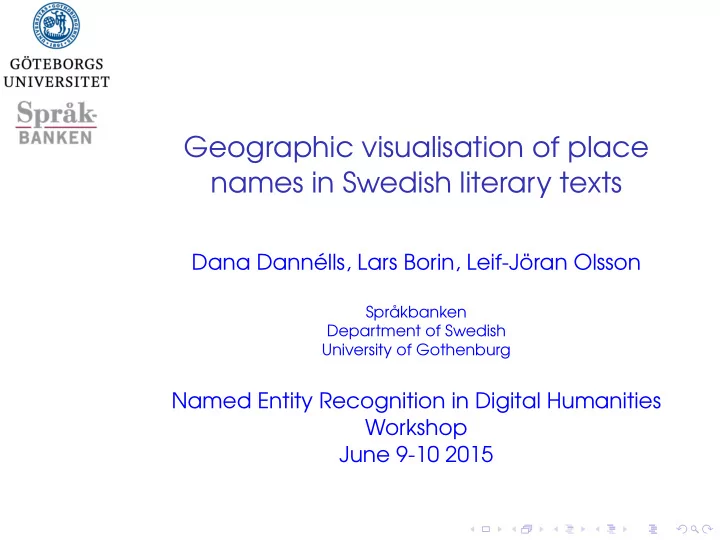

Geographic visualisation of place names in Swedish literary texts Dana Dannélls, Lars Borin, Leif-Jöran Olsson Språkbanken Department of Swedish University of Gothenburg Named Entity Recognition in Digital Humanities Workshop June 9-10 2015
Geographical Information System (GIS) ◮ System for capturing, storing, checking and displaying data. ◮ Data is usually presented in a form of point, line pixel, or polygon can be combined with data that are in table form, or already in map form. ◮ It is well suited to mapping data, but also allows to explicitly research the geographic aspects of the data and change over time (favored in DH). ◮ Multiple layers of information can be displayed on a single map (rivers, roads, pollution, population, vegetation, etc.) ◮ Google Maps
Google Maps
Motivation Geographical locations which are found in older literary texts – e.g. no longer existing places or older name variants – are usually not available. The maps available on the internet are often non-distributable. We want to have meaningful data so we can answer questions like: – “where does the plot of the story take place?” – “what are the spelling variants of a place name for a certain period?” – “how has the location of places changed over time?”
Challenges ◮ How to recognize place names in historical texts ◮ lack of a standard orthography ◮ morphological variation ◮ How to render digital maps to present these historical locations ◮ missing place names in databases ◮ missing place name coordinates
Språkbanken Språkbanken, ’the Swedish Language Bank’, is a research unit which focuses on developing open linguistic resources and tools for use by researchers and online visitors from different research fields. The corpus resources offer access to a vast amount of written historical and literary texts. The lexicon resources offer access to modern and historical lexicons.
Method overview
Spelling variation of place names In text collections from the 18th and 19th centuries, we find the place names ‘Lapland’ and ‘Laplandiya’ which are spelling variants of the province Lappland .
Spelling variation Levenshtein distance calculations combined with a more specific linguistically informed method for distinguishing not only between different spelling variants but also between different variants given a certain period. e → ä : 0.2 Strengnäs Strängnäs W → V : 0.27 Wretstorp Vretstorp fv → v : 0.31 Skälfvum Skälvum mp → m : 0.45 hampn hamn (Ahlberg & Bouma, 2012; Adesam et al., 2012)
Morphological variation
Named entity recognizer (NER) ◮ Automatically extracts names across large collections of texts. ◮ Based on modern domain independent gazetteers. ◮ Some of the place names appearing in old literary texts are not always recognized. ◮ NER is combined with a place name lexicon for specific time periods.
Placename database
GeoNames geographical database geonameid : integer id name : name of geographical point (utf8) asciiname : name of geographical point (ascii) alternatenames : alternatenames latitude : latitude in decimal degrees longitude : longitude in decimal degrees feature class : see codes feature code : see codes country code : ISO-3166 2-letter country code cc2 : alternate country codes admin1 code : fipscode admin2 code : code for 2nd administrative division admin3 code : code for 3rd administrative division admin4 code : code for 4th administrative division population : bigint (8 byte int) elevation : in meters, integer gtopo30 : average elevation of 30’x30’ timezone : the timezone id modification date : date of last modification
GeoNames data Problem: spelling variation for specific time periods and no longer existing place names.
No longer existing place names Extracted from our corpora resources and soon also from Lantmäteriet (the Swedish mapping, cadastral, and land registration authority). Example 1: The capital of Norway is being referred to as ‘Christiania’ when mentioned in novels between 1624 and 1877 and as ‘Kristiania’ from 1877 to 1925, and after that as ‘Oslo’. Example 2: When the name ‘Danzig’ appears with its German name in a Swedish novel that is written before 1980, it is likely to refer to the Polish city ‘Gdansk’.
Språkbanken’s place name database Språkbanken’s database differs from the GeoNames database in at least three ways: (1) fewer redundant place locations; (2) spelling variants found for particular place names and time periods; (3) explicit information about place names from different time periods.
Coordinate search I getcoordinates.php < Växjö, Gävle, Karlstad
Coordinate search II getcoordinates.php < Berget
GIS at Språkbanken ◮ The open source MapServer platform (Kropla 2005). ◮ The geographical data is derived from Open Street Map dataset. ◮ The development environment has a user interface. ◮ Generate interactive maps, static and dynamic.
Place-name visualization from Swedish literary texts Det går an from 1838 by Carl Jonas Love Almqvist mentions more than 10 place names: Stockholm, Riddarholmsstranden, Mälaren, Södertelje, Strengnäs, Granfjärden, Glanshammar, Trufverö, Västerås, Kungsör, Westgötaland, Wenern, . . . Nils Holgerssons underbara resa from 1962 by Selma Lagerlöf mentions more than 50 place names: Fjällbacka, Frösön, Garpenberg, Glimminge, Grövelsjön, Gullöfallet, Görälven, Göta kanal, Göteborg, Haga, Lappland, Lidingön, Skara, . . .
Static map generated for Det går an
Dynamic map generated for Nils Holgerssons underbara resa
Conclusions ◮ We address some of the challenges with orthographic and morphological variation, missing place names, and missing place name coordinates. ◮ These challenges form a central part in the development of methods and tools for the automatic analysis of historical Swedish literary texts at our research unit. ◮ MapServer offers new opportunities for visualizing geographical information of place names found in our corpora.
Thank you!
Recommend
More recommend